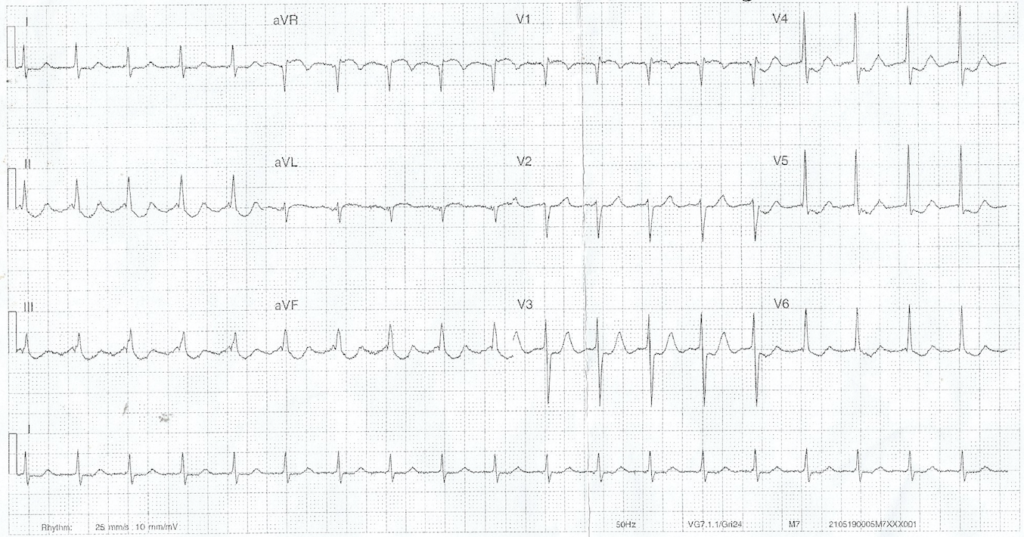You have requested an ECG for a 91 year old lady who has multiple co-morbidities and lives in a nursing home. She has presented short of breath. Her ECG is as below.
Interpretation:
- Rate: 114
- Rhythm: Flutter (easily confused as sinus when looking at anterior leads, flutter waves seen pre QRS and in T wave in lead II)
- Axis: Normal (0-90)
- Morphology: 1.5mm STE aVR, 1mm STE V1, subtle 0.5mm STE aVL, widespread 1-2mm downsloping STD (seen in leads II, III, aVF, V3-6) more subtle 1/2mm STD in I
- Intervals: QRS 80 QT 320 QTc 445 (Bazetts)
- Summary: An interesting ECG!
Discussion:
ST elevation in aVR and global ST depression elsewhere is highly indicative of diffuse subendocardial ischaemia which is seen in a variety of cases where the oxygen supply and demand are mismatched. Thinking of it in this manner the STE in aVR is essentially a reciprocal change to the left leads of I,II, aVL, V4-6 as it is electrically opposite (remember aVR overlies atria only not myocardial wall)
Causes include
- LMCA or Proximal LAD stenosis
- Studies have shown that STE of >= 1.5 mm is associated with up to 70% mortality
- Triple vessel disease
- Hypoxia – eg PE
- Hypotension – eg post ROSC, blood loss
Implications for Management:
This would depend entirely on this ladies history.
Differentials include:
- LAD/LMCA stenosis
- If she had presented with clinical symptoms of MI she should be managed as a STEMI equivalent (whilst taking into consideration her co-morbidites and functional capacity given she is a 91 year old NH resident) The main change in management would be withholding ticagrelor / clopidogrel if she was a candidate for CABG (increased risk of major bleeding)
- You could also consider this diagnosis given she is elderly (especially if there was a Hx of DM) without CP as a silent MI with or without secondary APO
- Rate related ischaemia
- less likely given rate is only 116 but in a 91 year old lady this may be possible
- Seen especially in AVNRT and flutter
- Mechanism not entirely known ? rate related supply and demand mismatch vs ‘unofficial stress test’ unmasking of CAD
- Other causes of SOB causing supply and demand subendocardial ischaemia
- PE
- LRTI
- COPD etc
- APO
With thanks to Dr Fiona Beattie and Dr Prathiba Shenoy for their help with interpretation!
Further Reading –
Textbook:
Chan TC, Brady WJ, Harrigan RA, Ornato JP, Rosen P. ECG in Emergency Medicine and Acute Care. Elsevier Mosby 2005.
Online:

